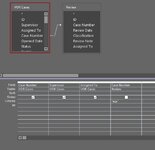Hello, I search the site and could not find this answer. I'm working with Access and I have two tables each having a column with the same information, I want to use conditional formatting to find the duplicates.
This is what I'm using in the expression part of a new rule. =countif( [Review]![Table1]= [Table2]![Case Number],0).
What I get is you may have entered a comma without a preceding value or identifier. I have no commas in the expression.
Any help would surely be appreciated.
This is what I'm using in the expression part of a new rule. =countif( [Review]![Table1]= [Table2]![Case Number],0).
What I get is you may have entered a comma without a preceding value or identifier. I have no commas in the expression.
Any help would surely be appreciated.






